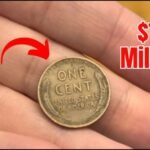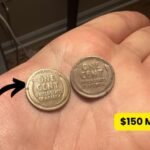Have you ever picked up a penny and thought, “Could this tiny coin actually be worth millions?” While it might sound unbelievable, it’s a reality for a select few. One variation of the Lincoln Wheat Penny—specifically the elusive 1943 copper edition—has fetched a jaw-dropping $13 million at auction. Yes, we’re talking about a single penny.
This seemingly ordinary piece of change, often overlooked and tossed aside, has become one of the rarest and most sought-after coins in American history. What makes it so special is that it wasn’t supposed to exist at all.
Lincoln Wheat Penny:
A Wartime Coin with a Twist To understand the value of this coin, we have to go back to 1943, when the world was engulfed in World War II. Resources like copper were desperately needed for the war effort—used in manufacturing ammunition, wiring, and other essential military equipment. To conserve copper, the U.S. Mint made a major shift. Instead of the usual copper composition, pennies were minted using zinc-coated steel.
However, amidst the chaos of wartime production, a few copper planchets (coin blanks) from 1942 accidentally remained in the minting machines. These planchets were stamped with the 1943 date and entered circulation unnoticed. These rare Lincoln Wheat Penny coins are now known as the 1943 copper pennies, and only an estimated 20 to 30 authentic specimens are known to exist.
Lincoln Wheat Penny: Why It Commands Millions You might be wondering, why would anyone pay millions for a one-cent coin? The answer lies in a potent mix of rarity, historical relevance, and collector enthusiasm. The 1943 copper Lincoln Wheat Penny wasn’t just a fluke—it’s a symbol of a unique time in history when every material had value and every resource was maximized for national survival.
Combine that significance with extreme scarcity and pristine preservation, and you have the perfect storm for a collector’s dream. In fact, a flawless 1943 copper Lincoln Wheat Penny once sold for nearly $13 million, making it one of the most valuable coins ever traded.
Lincoln Wheat Penny: Spotting the Real Deal If this story has you racing to your change jar, you’re not alone. But how do you know if you’ve found one of these rare coins? First, examine the date. If you find a penny marked 1943, there’s a chance you’re onto something. But here’s a quick test: grab a magnet.
Most 1943 Lincoln Wheat Pennies were made of steel, which means they’re magnetic. A genuine 1943 copper penny will not stick to a magnet. However, that’s just the first step. Counterfeit versions are common—some are steel pennies plated with copper, while others are altered 1948 pennies with modified digits.
Lincoln Wheat Penny: The Importance of Professional Authentication Before celebrating, make sure to get your coin evaluated by a professional coin grading service. These experts will examine its weight, metal content, and mint characteristics to determine whether it’s genuine. Without this step, you risk mistaking a clever fake for a rare gem or, worse, selling a million-dollar coin for just a few bucks.
Lincoln Wheat Penny: True Stories of Unbelievable Finds What makes the Lincoln Wheat Penny tale even more compelling is that people have actually discovered these coins in everyday life. Some stumbled upon them in inherited coin collections, while others found them in bank rolls or as change from stores. For those lucky few, what seemed like an ordinary coin turned out to be a life-changing windfall.
Lincoln Wheat Penny: Other Rare Editions Worth Watching The 1943 copper version is undoubtedly the crown jewel, but it’s not the only valuable Lincoln Wheat Penny. Other editions have also turned heads in the coin-collecting world:
- 1909-S VDB: This penny was the first edition of the Lincoln cent and includes the initials of its designer, Victor David Brenner. It’s worth over $100,000 in top condition.
- 1944 Steel Penny: A reverse error of the 1943 copper coin, this one was struck in steel when production had returned to copper. Its value can range from $75,000 to over $500,000.
- 1955 Double Die Penny: This coin features doubling in the date and inscriptions, making it highly collectible. In good condition, it can command up to $50,000.
Lincoln Wheat Penny: More Than Just a Coin What draws collectors to the Lincoln Wheat Penny isn’t just its monetary value, but the blend of history, rarity, and the personal stories behind each find. Coin collecting becomes more than just a hobby—it turns into a modern-day treasure hunt. The idea that a simple penny in your pocket might be a multimillion-dollar artifact adds a layer of excitement to every transaction.
Next time you receive change at a store, take a moment. That ordinary-looking penny could be a hidden gem. The odds might be slim, but they’re not zero—and that’s enough to keep the thrill alive for collectors and casual observers alike.
Lincoln Wheat Penny: The Rise of Modern Collecting In today’s digital age, with the rise of credit cards and online payments, physical coins might seem like relics of the past. But in the coin-collecting community, interest in the Lincoln Wheat Penny has only grown. Social media groups, online auction sites, and educational forums have made it easier than ever for people to share discoveries, seek expert opinions, and buy or sell rare coins.
Even young collectors are getting in on the action, inspired by stories of six-figure finds and the cultural legacy behind the Lincoln Wheat Penny. Schools and historical societies often use these coins as educational tools, linking students to an important chapter in American history.
Lincoln Wheat Penny: Tips for Aspiring Collectors If you’re new to the world of coin collecting and hope to get lucky with a Lincoln Wheat Penny, here are a few tips to help you get started:
- Get a Magnifying Glass: Many errors and rare variations are only visible under close inspection.
- Sort Your Change: Make it a habit to look through every penny you receive. Rare coins often pop up in the most unexpected places.
- Invest in a Coin Album: Keeping your collection organized not only preserves condition but also helps track what you have.
- Do Your Research: Read up on rare coins and common counterfeits. The more you know, the better equipped you’ll be to spot something valuable.
- Join Collector Communities: Whether it’s online or in-person coin clubs, being part of a community offers support, insight, and inspiration.
Lincoln Wheat Penny: Final Reflections In a world where fortunes are often tied to tech stocks or real estate, the idea that a forgotten Lincoln Wheat Penny could change someone’s life is both nostalgic and thrilling. It serves as a reminder that history still lives in our pockets—sometimes quite literally.
The Lincoln Wheat Penny represents more than just currency. It’s a piece of American history, a symbol of resilience, and a potential key to unexpected wealth. Whether you’re a seasoned numismatist or someone who just enjoys the thrill of the hunt, never underestimate the power of a penny.
So the next time your fingers brush against a coin at the bottom of your purse or pocket, take a second look. That little Lincoln Wheat Penny might just be worth a lot more than you think.
Some Important Link
| Telegram Group | Click Here |
| WhatsApp Group | Click Here |
| Home Page | Click Here |




